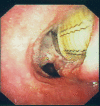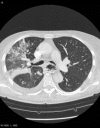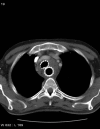Airway and esophageal stenting in patients with advanced esophageal cancer and pulmonary involvement
- PMID: 18769726
- PMCID: PMC2518104
- DOI: 10.1371/journal.pone.0003101
Airway and esophageal stenting in patients with advanced esophageal cancer and pulmonary involvement
Abstract
Background: Most inoperable patients with esophageal-advanced cancer (EGC) have a poor prognosis. Esophageal stenting, as part of a palliative therapy management has dramatically improved the quality of live of EGC patients. Airway stenting is generally proposed in case of esophageal stent complication, with a high failure rate. The study was conducted to assess the efficacy and safety of scheduled and non-scheduled airway stenting in case of indicated esophageal stenting for EGC.
Methods and findings: The study is an observational study conducted in pulmonary and gastroenterology endoscopy units. Consecutive patients with EGC were referred to endoscopy units. We analyzed the outcome of airway stenting in patients with esophageal stent indication admitted in emergency or with a scheduled intervention. Forty-four patients (58+/-\-8 years of age) with esophageal stenting indication were investigated. Seven patients (group 1) were admitted in emergency due to esophageal stent complication in the airway (4 fistulas, 3 cases with malignant infiltration and compression). Airway stenting failed for 5 patients. Thirty-seven remaining patients had a scheduled stenting procedure (group 2): stent was inserted for 13 patients with tracheal or bronchial malignant infiltration, 12 patients with fistulas, and 12 patients with airway extrinsic compression (preventive indication). Stenting the airway was well tolerated. Life-threatening complications were related to group 1. Overall mean survival was 26+/-10 weeks and was significantly shorter in group 1 (6+/-7.6 weeks) than in group 2 (28+/-11 weeks), p<0.001). Scheduled double stenting significantly improved symptoms (95% at day 7) with a low complication rate (13%), and achieved a specific cancer treatment (84%) in most cases.
Conclusion: Stenting the airway should always be considered in case of esophageal stent indication. A multidisciplinary approach with initial airway evaluation improved prognosis and decreased airways complications related to esophageal stent. Emergency procedures were rarely efficient in our experience.
Conflict of interest statement
Figures



References
-
- Herskovic A, Martz K, al-Sarraf M, Leichman L, Brindle J, et al. Combined chemotherapy and radiotherapy compared with radiotherapy alone in patients with cancer of the esophagus. N Engl J Med. 1992;326:1593–1598. - PubMed
-
- Gudovsky LM, Koroleva NS, Biryukov YB, Chernousov AF, Perelman MI. Tracheoesophageal fistulas. Ann Thorac Surg. 1993;55:868–875. - PubMed
-
- Schaer J, Katon RM, Ivancev K, Uchida B, Rösch J, et al. Treatment of malignant esophageal obstruction with silicone-coated metallic self-expanding stents. Gastrointest Endosc. 1992;38:7–11. - PubMed
-
- Do YS, Song HY, Lee BH, Byun HS, Kim KH, et al. Esophagorespiratory fistula associated with esophageal cancer: treatment with a Gianturco stent tube. Radiology. 1993;187:673–677. - PubMed
-
- Morgan RA, Ellul JPM, Debton ER, Glymos M, Mason RC, et al. Malignant esophageal fistulas and perforations: Management with plastic-covered metallic endoprotheses. Radiology. 1997;204:527–532. - PubMed
MeSH terms
LinkOut - more resources
Full Text Sources
Medical

